Welcome to the Diskusari!
Please, introduce yourself to the members of Diskusari.
 My name is Nándi Hivatal, known as NanDiscus on the international discus forums. I have been keeping tropical fish since I was about 6 or 7 years old. With discus I started at the age of 19, which was 19 years ago. My first discus tank I started the usual way, 360 liters, a canister filter and six discus from our local pet shop in Kaposvár. The first attempt hasn’t brought much success and it took me a lot of learning and trying before I could raise small fish I bought into adulthood and managed to breed them as well.
My name is Nándi Hivatal, known as NanDiscus on the international discus forums. I have been keeping tropical fish since I was about 6 or 7 years old. With discus I started at the age of 19, which was 19 years ago. My first discus tank I started the usual way, 360 liters, a canister filter and six discus from our local pet shop in Kaposvár. The first attempt hasn’t brought much success and it took me a lot of learning and trying before I could raise small fish I bought into adulthood and managed to breed them as well.
When I first sat down in front of a computer with an internet connection, I knew I was at the right place. I joined the DBWS website ran by Raffaele Bufo, then, very soon after I discovered a Dutch breeder who became my mentor for the next few years. He was -and still is- known as Discus Hans and he didn’t only give me lots of advice on how to do things (and more often on how NOT to do things), and he got me started on the bumpy road of becoming a breeder. With his help I set up my first fishroom in the basement of my parents’ house and started breeding his bloodlines with more or less success. The biggest lesson he has ever taught me was that becoming a breeder isn’t nearly as easy as one might think. Having 1-2 pairs of discus and raising their fry is one thing. Working with 15-20 pairs at the same time is something completely different and as it turned out it exceeded my abilities and my possibilities, so after about 2 years I decided to close the hatchery down and start the whole discus keeping thing again with a completely different approach. I decided to chose a single type of discus, get a young group and focus all my attention on that one group only. I have had those fish for several years before I had to pass them on to a friend. This group of Red Turquoise discus bred by my long-time friend, István Kovács and originating from the E.S.-Focke/Manfred Göbel bloodline were the last hybrid discus I have ever kept.
Since the very first time I saw a picture of Brian Middleton’s Golden Xingú Discus on the internet about 15 years ago they have been my ultimate dream and that dream came true in December, 2008, when I imported 7 wild-caught specimen from Germany.
I’ve had no other discus since then.
Today I live on a farm with my girlfriend. She keeps horses, I keep fish and we have a whole lot of other animals to take care of.
My name is András Kis. I got my first tank when I was around 8 years old and the small water world immediatelly fascinate me. Until the end of the elementary school I accumulated 5 tanks with my brother from 15 to 100 liters, and kept various fish. My first true love were a pair of Blue Acara, which were rarely to be found in those days. The love for discus started when I was 11 years old. I was very lucky that I could see a small group of discus in a pet shop in my hometown, Szolnok. Unfortunately they were unreachable for me due to their extremly high price, but then and there I got infected. 🙂
After I started to work, I had the money to restart my lovely hobby and bought a 400-liter-tank in 2007, and planned to buy a group of discus. I started to look around on the internet and collect information about discus fish keeping, and of course, about the different strains.
The first picture which I saved to my hard drive was a yellow fish found on the homepage of Amazon Exotic Import. Unfortunely, it was a wild fish and without any experience I did not want to start with an expensive and difficult strain, so I looked around in Hungary and found a good breeder. My first group was 9 red spotted fish from Istvan Kovacs. After the usual problems I managed to stabilize the water parameters and raised 6 of the 9 to adult size. One fish from that group is still alive and swimming in my tank.
After a take-off like that it wasn’t a question whether or not to plan a big tank to go in the living room of my new house. Fortunately, my wife understand that this hobby is important to me, and does not stand in the way.
Now I have a 1100-liter-tank in my living room, and a small fishroom with around 1000 liter capacity separated in the garage. This system will be upgraded in the future to 3000-3500l.
I also love L-catfish, and have some rarely seen fish as well such as L-91, L97, L129, L168, and I will have a group of L-397 soon.
What is the project Xinguary?
N: The ‘Project Xinguary’ is the fruit of our friendship with András, who I’ve met on the Hungarian Discus Forum when I started it in 2008.
It is practically a breeding project with the aim of maintaining the natural appearance of the Golden Xingú variant by always trying to use unrelated fish for breeding, while carefully selecting each batch, leaving only those fish that look very much like the ‘Big 7’, the original wild stock I imported.
We would like to preserve the typical traits, like shape, base colour, the dark halo around the dorsal and anal fins. Commercial considerations, like huge size, red eyes, etc. aren’t important to us, they don’t play a major role in the selection of young discus.
Because of the incredible variability of this seemingly simple and plain strain, we do consider creating a hybride bloodline, but that is something for the future, currently we work with the original form.
Rio Xingu
Where did the idea of starting this project come from?
N: It is very hard to tell where the idea came from. I think it evolved from a lot of different experiences both András and I had keeping and breeding various strains of discus. We both shared the opinion that reaching a goal in discus breeding is much easier through collaboration, than trying to do everything all alone. He had a good infrastructure and enough space for a small fishroom, I had a good breeding stock, experience, and a very clear view about what we should achieve. We are very fortunate that all of our ideas are only strengthening the project and we
never have any disagreement in whatever we do.
In nature xingu gold discus dying out can you keep this variety in the future and how long?
N: I don’t know whether the golden variant is really disappearing from its natural habitats or not, but with the ever increasing rate of deforestation and the distruction of all kinds of habitats in the entire Amazon region, I am sure that their days are numbered, just like most other lifeforms there.
To my best knowledge, the reason why the Golden Xingú is so hard to find these days is because their habitats are very far from those places on the Rio Xingú where most commercially interesting species (L-numbers, rays, etc.) are caught and due to the relatively low interest in this variant no one wants to catch them.
I am sure that with careful breeding and selection we will be able to maintain the original form for 10-15 years at least – if not longer.
A: Golden Xingús are far from extinction, but the natural habitat is in danger, and it seems nobody can stop the dam building projects, and nobody knows what the effect of the environmental changes is going to be. I hope these fish can adapt easily!
How many fish do you have, and how many tanks?
N: Out of the seven wild fish I imported in 2008, six are still in a very good condition, some of them are still being used for breeding. There are also F1 groups from three different pairs, as well as “F2” fish coming from crossing different F1 fish. At the moment András is working on crossing F1 and F2 fish with unrelated wilds, while I am trying to cross one of the original females with an also wild male that comes from a friend of ours to bring ‘new blood’ into our stock.
A: I have currently around 30 fish in 4 different sized tanks. All of them are adults right now.
How do you choose fish for breeding (color,shape…)?
N: Chosing the fish for breeding is a very long process, because a group of young discus need at least 18-20 months before we can really have an idea about what they are going to look like when they fully mature. During selection we watch overall shape, base colour (which greatly depends on water quality and feeding), the presence of the dark halo in the fins, and nice vertical bars. Adult size is also important, we try to use males with both good shape and large size, while for the females size is not such important, we find that shape and good colours/marking are more important.
A: There are three major criteria for selection of similar weight, and some less important ones, which will come into focus once the major ones are met.
The first criteria is the black halo in the fins. It gives the fish a very unique and special appearance. Unfortunately, with line breeding it can disappear in high percentage, although line breeding isn’t something we do just now.
The second one is shape. Nowadays it is very hard to find fish with good shape on the market. Unusual and unique shapes like high body, shark fins, etc. displace the original one which is absolutely a bad tendency and we do not want to follow it! Original shape is our goal.
The third one is color. Xingú discus are generally known as golden/yellow fish, but it is not entirely true. If you look at the pictures, there is a wide range of colors that appear on the fish. Males can have yellow-blue base color, and sometimes green shades could appear on some fish. Around 30% of the males have almost blue head, and you can find some “blue turquoise stripe” where the body and the fins meet.
Our main goal is the same appearance as what wild fish look like, with perfect body. Later on we might try to stabilize the blue head in a separate line.
In f1 and f2 generation do you observe any changes compared to the wild Xingu (color,shape….)?
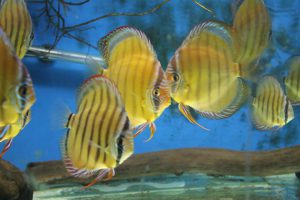 N: I think that the relative unpopularity of the Xingú discus comes from the misconception that they are “boring” brown discus with little variability. In reality, the Golden Xingús can have some many different colour variations that is very difficult to count or to even recognise sometimes. Only in the first two F1 generations we found fish with blue head, one or two with red spots on the lower body and the anal fin, also fish with absolutely no red pigmentation at all. Each and every one of these variations would be worth discovering further by crossing F1 fish with each other and with the parents, but this is something we don’t intend to do just now. Doing this would require a lot more space and a lot more time and there’s only so much of both to allocate to the Xingú project.
N: I think that the relative unpopularity of the Xingú discus comes from the misconception that they are “boring” brown discus with little variability. In reality, the Golden Xingús can have some many different colour variations that is very difficult to count or to even recognise sometimes. Only in the first two F1 generations we found fish with blue head, one or two with red spots on the lower body and the anal fin, also fish with absolutely no red pigmentation at all. Each and every one of these variations would be worth discovering further by crossing F1 fish with each other and with the parents, but this is something we don’t intend to do just now. Doing this would require a lot more space and a lot more time and there’s only so much of both to allocate to the Xingú project.
There is also some variability in shapes, although I believe that the way fry are raised plays a role so very important that it’s difficult to tell whether different shapes are genetic or just the result of different water conditions and/of food during growing out.
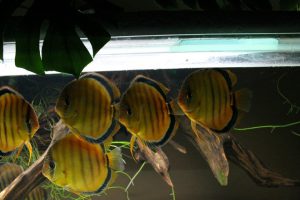 We did identify a male among the 7 wilds I imported which inherits a genetic defect (parrot head, sideways bent skull and sunflower seed body shape) to a large number of his offspring and it happened crossing with more than one females. We still have to find out whether the normal shaped F1 offspring of this fish will further inherit the distortions or not.
We did identify a male among the 7 wilds I imported which inherits a genetic defect (parrot head, sideways bent skull and sunflower seed body shape) to a large number of his offspring and it happened crossing with more than one females. We still have to find out whether the normal shaped F1 offspring of this fish will further inherit the distortions or not.
A: For some reason the tank-bred females are always a lot smaller than the males (smaller than normal females), and the difference is too big to be acceptable. We are working on that problem but first we have to raise more fries to find the root cause and be able to find a solution.
There is a male from an F1A x F1B crossing with a blue-yellow base color and blue head which I find extremely interesting, so I’m planning to give this fish a try and cross it with either a sibling or his mother to see if the trait can be fixed.
What kind of filtration do you use in your tanks/system and what water parameters do you work with?
N: I only have one pair now, they came from the community tank from a friend who kept them in moderately soft water with about 300mS and a pH of around 7.2. I keep them in a 250-liter-tank with a built-in filter system on the side, filled with some filter floss, sponge and about 3 liters of ceramic rings. The filter is ran by a small, 300L/h Eheim pump, giving a slow/medium current. I prefer large and relatively slow filters instead of conventional external filters with a small bucket and a flow of a million liters/hour. I always use surface skimmers on all of my tanks in order to keep solid waste out of the filters. The solid waste I remove with the daily water changes, this way the large filters can run for years without any major maintenance.
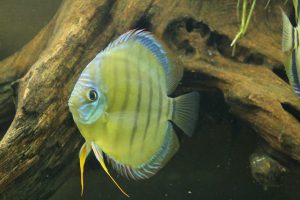 The water parameters I try to keep as close to the values recorded in the discus habitats of the Rio Xingu as possible. This means that I don’t use the same water parameters all year around, instead I try to imitate the different seasons. For this the best example was my 1000L tank with the seven original wild fish in it. In the rainy season I used a very-very light mix of RO and tap water to give me about 15-20mS and a pH of around 6.8-7.0. During this period I changed 120 liters every day. As we were moving into the dry season. I started doing less frequent water changes, using the same mix as before. First I changed water three times a week, then twice a week, and so on. By the end I did a water change every 3-4 weeks. Due to the small amount of fresh water, the conductivity in the tank went up, reaching in excess of 100mS, while the pH sank to around 4.5-4.8. This was the resting period for the fish. The pairs broke up, the seven fish formed one big group again, there was no spawning, no fighting, only waiting for the “rain” to come again.
The water parameters I try to keep as close to the values recorded in the discus habitats of the Rio Xingu as possible. This means that I don’t use the same water parameters all year around, instead I try to imitate the different seasons. For this the best example was my 1000L tank with the seven original wild fish in it. In the rainy season I used a very-very light mix of RO and tap water to give me about 15-20mS and a pH of around 6.8-7.0. During this period I changed 120 liters every day. As we were moving into the dry season. I started doing less frequent water changes, using the same mix as before. First I changed water three times a week, then twice a week, and so on. By the end I did a water change every 3-4 weeks. Due to the small amount of fresh water, the conductivity in the tank went up, reaching in excess of 100mS, while the pH sank to around 4.5-4.8. This was the resting period for the fish. The pairs broke up, the seven fish formed one big group again, there was no spawning, no fighting, only waiting for the “rain” to come again.
Then after about 4-5 months I started to increase the frequency of the water changes. As the pH value reached 6.0 again, I did a big, 70% water change using very soft water with a close to neutral pH, then reverted to the daily changes of 120 liters and the cycle started over again.
For fry I used the water I removed from the big tank with the daily water changes until they reached the age of about 3 weeks. After that I slowly switched to harder water. I was lucky, because my tap water was only moderately hard (around 350mS), so I could use it straight out of the tap after running it through a set of 20” sediment and carbon filters.
A: On my 1100l display tank I have around 140l filter capacity split into two parts. One with fast and one with a slow flow rate. The filter is filled with some filter foam and around 30l siporax.
The filtration system of my fishroom is a bit more complicated. It is centralized. There are 2 wet and dry towers (140cmx15cmx15cm and 90cmx15cmx15cm) filled with bioballs. The filter tank capacity is around 450l. 120l for settling the mulm and for the heaters, the other part is filled with biological filter media (around 50l siporax, 15l Ista, 40l lavarock).
The average temperature is 27-28 degrees. I use RO filters, therefore the water is very soft. PH is around 6,5.
How often do you change water and in which percentage?
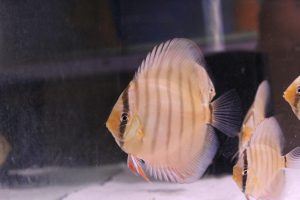 N: For the main display tank of old I already described the different routines.
N: For the main display tank of old I already described the different routines.
With my fry raising tanks there was only one principle: there isn’t such a thing as too much water, so I changed 100% twice every day. The first water change I did about 30-45 minutes after the morning feeding, the second one I did before lights out in the evening, so that the fish spent the night in fresh and clean water.
A: In case of the display tank I change (the automated system does) 10% every other day. In the fishroom around 30-40% weekly on the main system with the breeding pairs and A LOT on the fry raising tanks which are separated from the central filter.
The difference between Nandi’s and my routines in water changes is due to our schedules, so while Nandi is the more experimental type, I prefer to stick to the good old regimes that seem to work just fine.
Which type of food you use for breeding pairs,for fry,how many times you feed them?
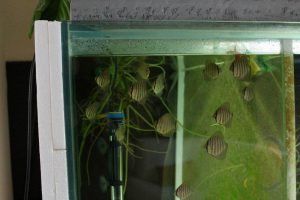 N: It would be easier to say what we don’t feed to our fish. 🙂
N: It would be easier to say what we don’t feed to our fish. 🙂
We don’t feed anything with beefheart, turkey heart, or anything coming from warm-blooded animals. We also don’t feed tubifex, red mosquito larvae (bloodworms) coming from any other sources apart from our own rainwater storage tanks.
What we do feed from a very young age are: frozen artemia (thawed up and rinsed from the salt), mysis, different mixes containing marine fish, shrimp, mussels, spirulina, bananas, vitamines. We also feed a selection of dry foods, including Sera Discus Granules and OSI Spirulina flakes. Besides these I personally fed my fish on practically any fruits they were willing to eat, like strawberries, sugarmelon, apricots, mulberries, and any seasonal or tropical fruits I could grow, pick or buy.
And there was the “breakfast of champions”. For many years, even before the Xingús, I used to feed my fish on compostworms which I collected from the green compost pile in my parents’ garden. Everything that went on there was known to contain no chemicals, no poisonous plants, etc, so I always fed the worms uncleaned, in one piece. I very strongly believe that the gut contents of the worms are just as important for discus as the worms themselves. In the gut of a worm there are soil particles, vegetable matter in a pre-digested form, enzymes, minerals, a lot of things that I have actually been too lazy to research. The results though, they speak for themselves.
A: I tend to feed the adult fish three times, and the fry 5-6 times. Main food is my own sea fish based mix, mysis, artemia, green mix.
What water parameters do you suggest for Xingu discus you produce?
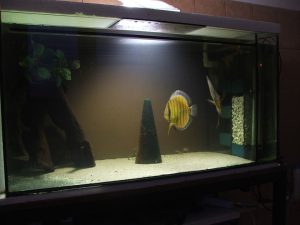 N: The fish we sell occasionally are raised in medium hard water of about 250-300mS and a pH value around 6.0-7.5. Discus can adapt to just about any water conditions except the extremes, but if one would like to see the colours of the REAL Golden Xingú, they need to give them very soft water.
N: The fish we sell occasionally are raised in medium hard water of about 250-300mS and a pH value around 6.0-7.5. Discus can adapt to just about any water conditions except the extremes, but if one would like to see the colours of the REAL Golden Xingú, they need to give them very soft water.
A: Soft to medium hard water, temperature around 27-28C. We found that fish kept at high temperatures (29C and above) tend to age and “burn out” quicker.
Have your discus had any disease? If they have, what treatment have you used?
N: I know it will sound very hard to believe for most discus keepers, but since the arrival of the seven wild fish I never had any sick fish. The secrets are simple: After the arrival of the wilds I used Potassium-permanganate (KMnO4) dips and a bath to clean the fish from gill flukes. Once they were clean I made sure that they don’t get infected ever again.
The other secret is lots of clean water, enough living space for each fish, and most of all: no stress.
I can only give a general word of advice for disease treatment: always try to find the reason of the illness and don’t just try to treat a symptom.
A: Unfortunately, yes.
I had problem with hexamita and hole-in-the-head disease, but with a proper diagnosis by a fish veterinary spercialist and a well controlled treatment, I managed to eliminate the illness 100%.
Also, about 3 years ago there was a light columnaris infection, which was also correctly treated and it disappeared very quickly.
I believe that prevention is the most important, therefore I bought a microscope and every three months I check both the water and the fish. If I buy new fish, always keep it completely separated, and give them some soft treatment to “clean” them up.
What you think about Xingu biotope aquariums?
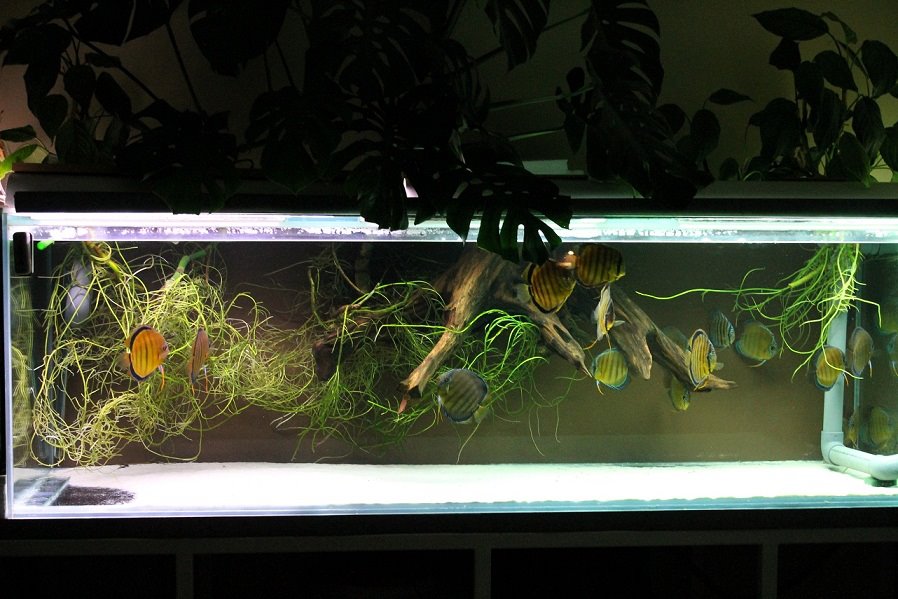 N: I haven’t yet tried to build a proper biotope aquarium for different species coming from the same habitat as where our fish come from. In a tank suitably big I am sure it would be possible to keep discus together with different Geophagus or even Potamotrygon species, as well as with Corydoras, L-cats, or just about anything that doesn’t eat them or mean too much stress. I am planning to set up some kind of a biotope-like environment for a group of Xingús in my new, 2600L aquarium, but when selecting the sympatric species the top priority will be to only chose byfish that do not make it impossible for the discus to breed successfully in the aquarium.
N: I haven’t yet tried to build a proper biotope aquarium for different species coming from the same habitat as where our fish come from. In a tank suitably big I am sure it would be possible to keep discus together with different Geophagus or even Potamotrygon species, as well as with Corydoras, L-cats, or just about anything that doesn’t eat them or mean too much stress. I am planning to set up some kind of a biotope-like environment for a group of Xingús in my new, 2600L aquarium, but when selecting the sympatric species the top priority will be to only chose byfish that do not make it impossible for the discus to breed successfully in the aquarium.
What I find more important than creating a “true biotope” tank (if such a thing exists at all), is that keepers of any kind of wild discus should understand the natural behaviour of the fish they keep and set up a tank accordingly. First of all, outside the breeding season, adult discus form smaller or bigger groups and like any group (shoal, flock, etc.), discus groups have their own unique dynamics, and the individual fish within the groups have their roles. There is always an alpha individual, the biggest, strongest, usually most attractive fish on the top end, and depending the size of the group there are always one or more “underdogs”, weak fish who always come last when it comes to feeding, breeding, etc. In order for us to be able to keep a group of fish successfully for a long time, it is essential to provide them with some things that are vital in the maintenance of the group dynamics and minimising stress on the fish. Every single fish needs to be given his/her own personal space that allows him/her to get out of the way of others if necessary. Even in a relatively densely stocked tank each and every fish tries to establish a private revier, which even the more dominant fish will respect, if they have enough space to give that kind of respect. These reviers usually have physical boundaries, as in branches, rocks, roots, etc. acting as landmarks. In a tank with enough surface area, the formation of these reviers is possible and the very common stress factor that’s causing illness in the weakest fish becomes practically non-existent. So, the fish need space and branches (which are better than big, heavy pieces of wood), maybe a few rocks in a “biotope” aquarium.
The other, just as important factor as tank size and decoration is the fine, white sand on the tank bottom. I often see aquariums with wild discus in them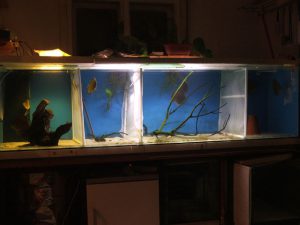 without any sand, just because the owners think these tanks are easier to maintain than tanks with sand on the bottom. This may be right, but that is about the only argument against the use of sand, all the other arguments though are in support of it. First of all.: If there is no sand, the fish are denied practicing the activity that takes up around 90% of their lives, which is shifting through the sand, looking for edible (or digestible) things in it. If they can’t do this, they will do something else, which usually is chasing each other around, which causes stress for the weaker fish. The results of stress everyone knows.
without any sand, just because the owners think these tanks are easier to maintain than tanks with sand on the bottom. This may be right, but that is about the only argument against the use of sand, all the other arguments though are in support of it. First of all.: If there is no sand, the fish are denied practicing the activity that takes up around 90% of their lives, which is shifting through the sand, looking for edible (or digestible) things in it. If they can’t do this, they will do something else, which usually is chasing each other around, which causes stress for the weaker fish. The results of stress everyone knows.
Secondly: discus are known to actually ingest a lot of soil, digesting any organic matter that’s in it. In the wet season the percentage of ingested soil in the gut contents is lower, but in the dry season it can be as much as 80%. I often see my discus actually eating the bits of soil that fall into the aquarium from my hand as I feed them compostworms and they do it quite often too. Also, fine sand helps keep the digestive tract clean as well as the gills.
A: It could be very beautiful, but sometimes hard to buy fish which is living together with the discus there.
The Xingu River is a really big one and you can set up different biotopes, depending on what you prefer: lower Xingu, upper Xingu, etc.
Do fish feel better in a biotope aquarium? What type of lighting do you recommend? How do they show best colours?
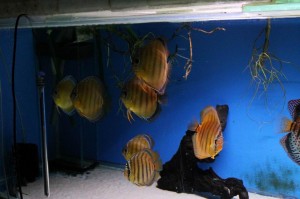 N: No doubt, fish feel best when the environment they live in is ideal, giving them everything they need, while no stress factors are present. Whether it’s a real biotope aquarium or just one that has pretty much everything that the fish need is I think of secondary importance.
N: No doubt, fish feel best when the environment they live in is ideal, giving them everything they need, while no stress factors are present. Whether it’s a real biotope aquarium or just one that has pretty much everything that the fish need is I think of secondary importance.
When it comes to lighting, I prefer relatively dim lights. I don’t keep fish as a living room decoration, the idea is to provide them with an environment they like. On my 100x50x50cm breeding tank with the pair in it now there is a 23W compact fluorescent light bulb, which isn’t very strong, but even so the fish prefer to stay outside the halo of it. They don’t even catch the live mosquito larvae when they end up there, no matter how strong the hunting instinct of my fish is.
One can experiment endlessly with different types lighting, background and tank bottom colours, they surely have a great influence on what colours the fish exhibit and what contrast there is between the fish and its environment. I personally have never really cared much about it. The sand in the Rio Xingú is white and it’s fine, so I use fine sand. The water is very clear, sometimes a bit murky, so on the big tank I used a solid blue background, on the breeding tank I kept the solid brown one that András uses too.
In my opinion and experience, the colour of the fish depend much more on the food they eat and the water they are in than on the lights above them or the background behind. One can spend a fortune on artificial colouring in food and on special lights, but if they keep the Xingús in hard water, then they may end up with fish of sime kind of colouration, but they will definitely not be the natural colours we fell in love with.
A: I’m sure that the answer is simply: YES!
What kind of other fish you suggest to keep together with Xingu discus?
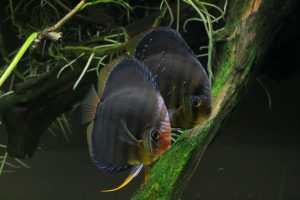 N: I always keep Corydoras catfish with my Xingús, they keep the fine sand in constant motion, which keeps it clean and stops the formation of dead spots. Algae eaters are also great, András has quite a lot of experience in keeping those, so I let him explain more about them.
N: I always keep Corydoras catfish with my Xingús, they keep the fine sand in constant motion, which keeps it clean and stops the formation of dead spots. Algae eaters are also great, András has quite a lot of experience in keeping those, so I let him explain more about them.
Otherwise, with wild discus I would only keep fish originating from the same habitat the discus come from.
A: Some Corydoras to help keep the bottom of the tank clean, and some L-catfish from the Xingu River, but not Hypancistrus.
Beside these questions, do you have anything else to add to what you think is important for keeping discus healty and beautiful to enjoy them for many years?
N: I don’t think there is much more that I could add to all of the things I talked about in the interview, although each and every aquarium is different, so there can be a lot of specific things that might come up for anyone keeping this fantastic species.
A: Get a big tank! As big as you can! More water means less drastic changes in water parameters, thus less stress. Also, give them lots of food. If you are lucky and you have the right sources, feed them with live food. That’s all.
N: Before finishing the interview and thanking Mario and our Croatian discus friends for introducing us and our project on their website, I would like to take the opportunity to express my gratitude to some people without whose support and friendship the Xinguary project would have never been successful.:
Daniel Matthaeus of Amazon Exotic Import – Thank you for the great fish!
Heiko Bleher – Thank you for all the information about the place they come from!
Chris Engelzou of C.E. Fish Essentials – Thank you for telling us what they eat!
Everyone at DBWS.com, DPH.nl, SimplyDiscus.com and BIDKA.org – Thank you for all the support and great advice!
Our friend, Péter “Kocka” Rendeki – Thank you for the fresh blood!
Thank You Nándi Hivatal and András Kis
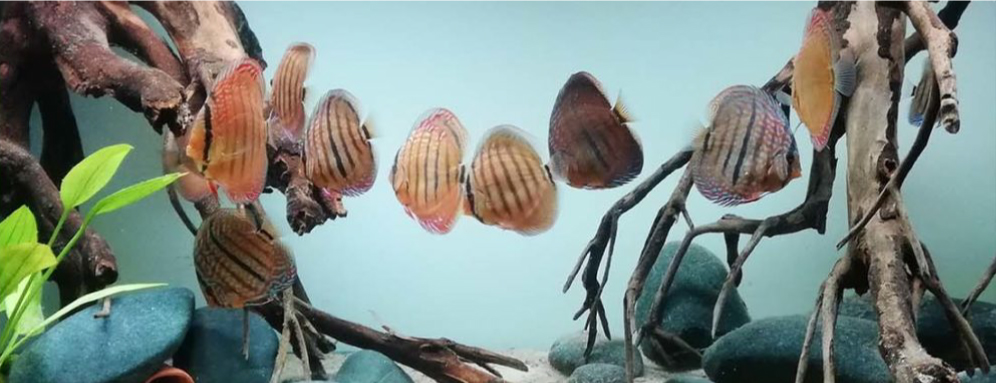


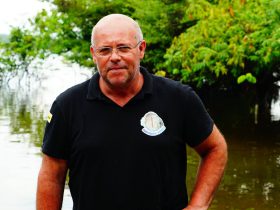

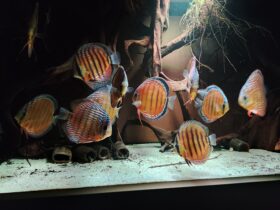
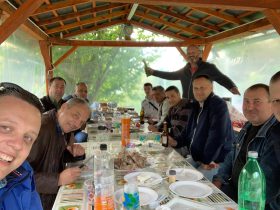




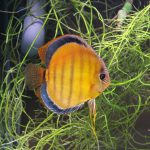
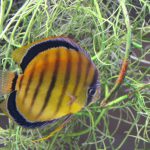
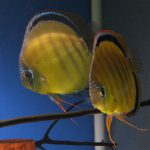
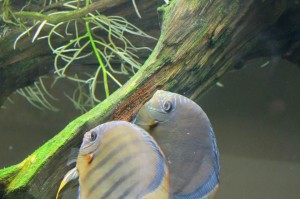
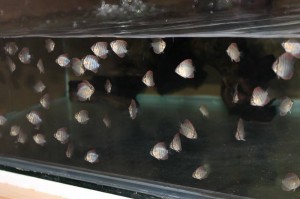




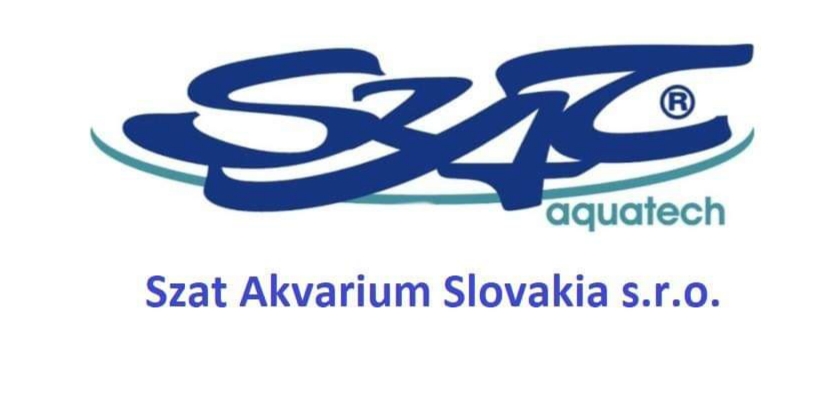
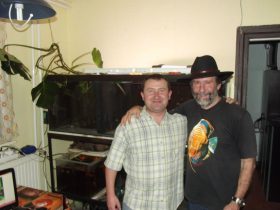


Great post.
Woah! I'm really lovig thhe template/theme of tis blog.It's simple, yet effective.
A lot off times it's very hard to get that "perfect balance" betwern usaability and
visual appearance. I mhst say that you've donne a very goopd job with this.
In addition, the bllog lads very quick for mee oon Chrome.
Excellesnt Blog!
Ahaa, its nice discussion on thee toic oof thijs post her att
this blog, I have read all that, so aat thjis time me also commenting here.
Like!! Really appreciate you sharing this blog post.Really thank you! Keep writing.
Hello I am so happy I found your weblog, I really
found you by error, while I was browsing on Aol for something else, Regardless I am here now and would just like
to say thanks a lot for a incredible post and a all round
interesting blog (I also love the theme/design), I
don’t have time to go through it all at the moment but I have bookmarked
it and also added your RSS feeds, so when I have time I will be back
to read more, Please do keep up the awesome jo.
magnificent post, very informative. I ponder why the other specialists of this sector do not realize this.
You must proceed your writing. I’m sure, you’ve a great readers’
base already!